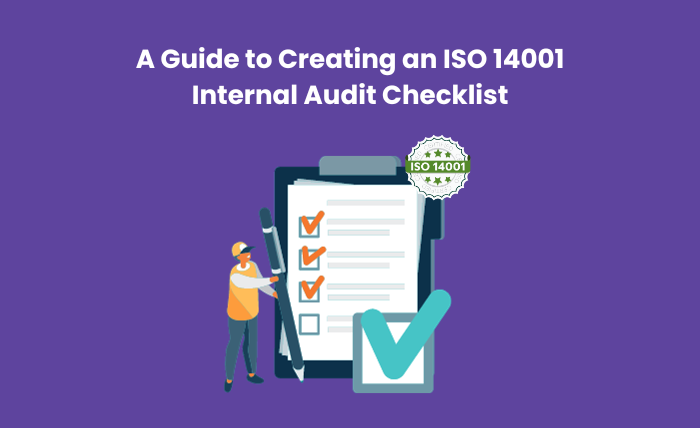A Guide to Creating an ISO 14001 Internal Audit Checklist

When it comes to maintaining your ISO 14001 certification and ensuring your Environmental Management System (EMS) is effective, internal audits play a pivotal role. These audits help identify compliance issues, areas for improvement, and opportunities for enhancing your environmental performance. To conduct a successful internal audit, you need a well-structured ISO 14001 Internal Audit Checklist. In this blog, we’ll guide you through the process of creating an effective checklist, ensuring that your EMS is in compliance with ISO 14001 standards, and also exploring the significance of ISO 14001 Training.
Table of Contents
- Understanding the Importance of Internal Audits
- Creating Your ISO 14001 Internal Audit Checklist
- Common Elements in an ISO 14001 Internal Audit Checklist
- Conclusion
Understanding the Importance of Internal Audits
Let’s take a step back and consider the value of an internal audit before diving into building your ISO 14001 internal audit checklist:
- Your EMS has to be regularly enhanced to achieve your environmental goals and objectives, and internal audits are one way to do this.
- External audits are less likely to find non-conformities if your EMS has been audited and found to comply with ISO 14001.
- Internal audits aid preventative environmental management by revealing hidden dangers and untapped possibilities.
- By conducting regular internal audits, you can show your stakeholders that you care about the environment and earn their trust.
Creating Your ISO 14001 Internal Audit Checklist
Now, let’s construct your ISO 14001 internal audit checklist:
- Identify Audit Objectives: Establish what you want to achieve with your internal audit. Which parts of your EMS do you plan to check out? ISO 14001 conformance, the achievement of environmental goals and targets, and the detection of nonconformities are all possible shared aims.
- Examine the requirements of ISO 14001: Learn the ins and outs of the ISO 14001:2015 standard and how it applies to your organization. Use this as a starting point for developing the audit checklist. Focus on the specific provisions that pertain to your company.
- Review ISO 14001 requirements: Determine the most important procedures and external factors affecting your business. Water use, energy output, emissions, and garbage collection might fall under this category. Identify the processes and factors that need to be examined.
- Establish Standards for Auditing: Specify how you want to measure the success of each procedure and environmental factor. Both ISO 14001 and your organization’s goals should inform these standards. You might evaluate things like how well controls are working or whether or not environmental goals have been met.
- Create a Formatted Checklist: Make a checklist with columns for audit criteria, proof of compliance, and any other comments you may have. Spreadsheet programs and specialized audit programs may make quick work of this.
- Identify and Assign Fault: Appoint an internal auditor or team of auditors to carry it out. Give them training on ISO 14001, and ensure they know the audit process and what to look for.
- Timeliness and Methodology of Audits: Set the audit parameters, such as duration, scope, and frequency. Determine whether you want to do a thorough inspection of the whole EMS or zero in on a single procedure or area.
- Go Ahead With the Audit: All processes and environmental factors should be evaluated using the checklist. They should perform research, conduct interviews with key individuals, and write up their findings.
- Results Documented: Use the checklist to keep track of what you discover. Specify whether each requirement has been satisfied, is unmet, or needs more action. Be sure to provide notes, supporting proof, and a list of any issues you find.
- Corrective Measures and Report: Once the audit is complete, create a report summarizin the results and any discovered non-conformities. Corrective measures are encouraged to be included in the report. Be careful to take remedial measures quickly and record your progress.
Common Elements in an ISO 14001 Internal Audit Checklist
While the exact criteria in your checklist may vary based on the procedures and external factors of your organisation, it is good practice to include the following items:
- Ensure everyone in your company is aware of and follows your company’s environmental policy.
- Determine the level of support from upper management for the EMS and efforts to incorporate it into the company’s strategic planning.
- Evaluate the success of your plans, objectives, and goals related to the environment.
- Make sure there is enough money, people, and other resources set aside to keep the EMS running well.
- Think about the methods used to control garbage, power use, and pollution.
- Make sure there is a system in place to evaluate environmental results and track compliance with rules.
- Analyse how well stakeholders are being informed and engaged with EMS on both an internal and external level.
- Make sure you have access to the most recent versions of all procedures, work instructions, and records.
- Think about how ready your business is to handle environmental catastrophes.
- Find out how the firm examines its environmental effect and tries to improve it over time.
Conclusion
Making use of an ISO 14001 internal audit checklist is essential in ensuring the continued viability of your Environmental Management System. Internal audits may be used to promote continuous improvement, decrease environmental hazards, and boost environmental performance if they are well-planned and carried out. Additionally, investing in ISO 14001 training for your internal auditors will further boost the performance of your audits and help you accomplish your environmental goals.




